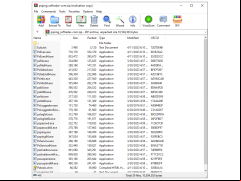Sysinternals. PsPing is a great tool for troubleshooting network problems and monitoring network performance.
PsPing is a powerful utility that allows s to measure network performance and latency. It can measure the response time of a network connection and the throughput of the connection. It can also measure the latency of a connection, and provide detailed information about the packet loss rate. PsPing can also be used to measure the latency of a single or multiple IP addresses or ports.
PsPing offers a wide range of features. It can measure the response time of a network connection, the throughput of the connection, and the latency of a connection. It can also provide detailed information about packet loss rate. PsPing can also measure the latency of a single or multiple IP addresses or ports.
PsPing also includes a powerful scripting language that allows s to automate network performance testing. It s both Windows and Unix-like systems.
PsPing can be used to identify the cause of slow or unreliable network performance. It can identify which server or application is causing the issue and can provide detailed information about the network latency and throughput.
PsPing can also be used to measure the performance of a web server or application. It can measure the response time of a web server or application and provide detailed information about the performance.
PsPing also s a wide range of protocols such as T, UDP, ICMP, and HTTP. It can also be used to measure the performance of an FTP server or a VoIP system.
In addition, PsPing can be used to monitor network performance in real-time. It can be used to monitor the latency of a network connection and provide detailed information about the performance of the connection.
Overall, PsPing is a powerful and versatile tool for measuring network performance and latency. It is an essential tool for troubleshooting network problems and monitoring network performance.
PsPing is a powerful utility that allows s to measure network performance and latency. It can measure the response time of a network connection and the throughput of the connection. It can also measure the latency of a connection, and provide detailed information about the packet loss rate. PsPing can also be used to measure the latency of a single or multiple IP addresses or ports.
PsPing offers a wide range of features. It can measure the response time of a network connection, the throughput of the connection, and the latency of a connection. It can also provide detailed information about packet loss rate. PsPing can also measure the latency of a single or multiple IP addresses or ports.
PsPing also includes a powerful scripting language that allows s to automate network performance testing. It s both Windows and Unix-like systems.
PsPing can be used to identify the cause of slow or unreliable network performance. It can identify which server or application is causing the issue and can provide detailed information about the network latency and throughput.
PsPing can also be used to measure the performance of a web server or application. It can measure the response time of a web server or application and provide detailed information about the performance.
PsPing also s a wide range of protocols such as T, UDP, ICMP, and HTTP. It can also be used to measure the performance of an FTP server or a VoIP system.
In addition, PsPing can be used to monitor network performance in real-time. It can be used to monitor the latency of a network connection and provide detailed information about the performance of the connection.
Overall, PsPing is a powerful and versatile tool for measuring network performance and latency. It is an essential tool for troubleshooting network problems and monitoring network performance.
PsPing allows s to measure both latency and bandwidth on a network connection.
PsPing is a command-line utility that runs on both Windows and Linux systems. It requires an operating system with the Windows NT or Windows Server 2000 or later. It also requires PowerShell to be installed and running on the system. The PsPing utility is available as a free from Microsoft's website.
PROS
Provides reliable network performance measurements.
Allows T, UDP, ICMP ping testing.
Simple, easy-to-use interface.
Allows T, UDP, ICMP ping testing.
Simple, easy-to-use interface.
CONS
Limited functionality compared to other network monitoring tools.
Requires technical knowledge to use effectively.
Lacks a -friendly interface.
Requires technical knowledge to use effectively.
Lacks a -friendly interface.
Scott Harpool
I recently used PsPing for a network testing project and was impressed by its simplicity and reliability. It was easy to install and I liked that the command line interface was straightforward and well-documented. PsPing is also very versatile - I was able to use it to test layer-4 and layer-7 protocols, including HTTP, FTP, and ICMP. The graphical reporting tool was also nice, giving me a visual representation of the results. PsPing was a great help in my project and I would recommend it to anyone in need of network testing or troubleshooting tools.
Lewis G.
PsPing has a very straightforward interface. It's easy to use and it shows the results of the tests quickly. It also has some useful options and settings. It's a great tool for troubleshooting network performance. It's also lightweight and doesn't take up much resources.
Joseph S.
PsPing is a command-line tool used for network performance testing and measuring packet loss, latency, and bandwidth. It can be used to test network connectivity, troubleshoot network issues, and evaluate network performance. It s T, UDP, and ICMP protocols and can perform both client and server-side tests. PsPing also provides advanced features, such as the ability to customize packet sizes, measure jitter, and test against specific ports.
Ryan D.
PsPing software is a useful tool for measuring network latency, bandwidth, and other network metrics.
Freddie
Reliable for network latency testing, -friendly interface.
George
Reliable for network diagnostics.
Jacob
Ping tool for testing network latency and bandwidth.
Adam
It's an impressive command-line tool for measuring network performance and latency. Belonging to Microsoft's Sysinternals PsTools suite, it's useful for troubleshooting network issues and monitoring its performance. It can measure the response time of a network connection, its throughput, and even packet loss rate. It's even capable of measuring the latency of one or multiple IP addresses or ports. This tool also includes a powerful scripting language for automating network performance tests, and it's compatible with Windows and Unix-like systems.








